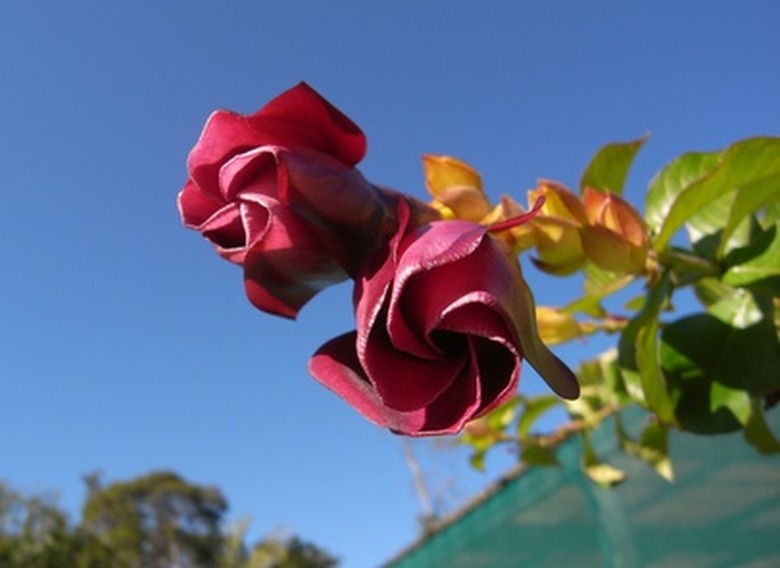Mandevilla Vs. Trumpet Vine
In a tropical, frost-free garden, weighing the cultural and ornamental merits between the Mandevilla (Mandevilla spp.) and golden trumpet (Allamanda spp.) vines can cause mild anxiety. If you have a sturdy trellis with lots of space, give more consideration to the various varieties and hybrids of Allamanda species, but if narrower spaces and posts need a tidy covering, any Mandevilla species may prove best. Grow either in USDA hardiness zones 10 and warmer.
Origins
Mandevilla vines are the results of many obscure and complex hybrids from plants native to South America. There are nearly 125 species of Mandevilla extant, most native to the northern Andes Mountains and western mountains in Brazil. Since modern Mandevilla vines possess such ambiguous genetic lineages and older botanical names, they sometimes are still called dipladenia vines. Golden trumpet vines, of the botanical genus Allamanda, also hail from tropical America, but the name usually refers to one species with a definite climbing habit, Allamanda cathartica, which is native to northeastern South America. Hybrids exist, adding to the floral color diversity among Allamanda vines sold at garden centers today.
- In a tropical, frost-free garden, weighing the cultural and ornamental merits between the Mandevilla (Mandevilla spp.)
- Golden trumpet vines, of the botanical genus Allamanda, also hail from tropical America, but the name usually refers to one species with a definite climbing habit, Allamanda cathartica, which is native to northeastern South America.
Growth Features
Mandevilla vines typically grow 10 to 12 feet tall with woody stem bases and more fleshy, herbaceous stems near their growing tips. These stems effectively twine and wrap around poles, fence links and trellises thanks to the "curious" snakelike, thin growing tips. The golden trumpet vine grows as a rambling, spreading climbing plant anywhere from 10 to 20 feet in height. Its woody stems grow both upward and outward, haphazardly climbing as these branches get tangled on supporting structures. It has neither tendrils or twining growth tips like the Mandevilla vine, but flops and grows wherever its stems gain support.
Ornamental Features
Both vine types sport attractive evergreen leaves: those of Mandevilla are dark green, while the golden trumpet vine's tend to be lighter medium green to deep yellow-green. The flowers of each are trumpetlike with five lobes. Thanks to modern breeding, Mandevilla vines bear red, rose, pink and white blossoms; golden trumpet vine's are typically bright canary yellow, although hybrids among Allamanda species now create some with mauve or pale pink blooms.
- Mandevilla vines typically grow 10 to 12 feet tall with woody stem bases and more fleshy, herbaceous stems near their growing tips.
Cultural Requirements
Grow Mandevilla vines in full to part-day sun exposure in a fertile, well-draining soil that remains moist in the growing season and slightly drier in winter. The soil pH must not be alkaline (over 7.2). This vine grows best when it's not too chilly or hot, since it's native to the tropical highlands. Thus, it tends to look best in spring and autumn in tropical climates. Golden trumpet vine likewise grows well in fertile well-draining soils but tolerates slightly more alkaline soils , although too much alkalinity leads to nutrient deficiencies and overly yellow foliage. Water well in summer's heat, but slightly less in the coolness of winter. A light frost defoliates both vines, but regrowth occurs on lower, undamaged stems.
- Grow Mandevilla vines in full to part-day sun exposure in a fertile, well-draining soil that remains moist in the growing season and slightly drier in winter.
Hazards
Both vines are members of the dogbane family, Apocynaceae. The milky latex sap that oozes from cut flowers, stems and leaves may cause irritation on bare skin. This sap also must not be eaten or gotten into the eyes or open wounds.
References
- "A-Z Encyclopedia of Garden Plants"; Editors Christopher Brickell and H. Marc Cathey; 2004
- Floridata: Mandevilla spp.
- "Tropical Flowering Plants"; Kirsten Albrecht Llamas; 2003
